Build a manufacturing career that builds the future
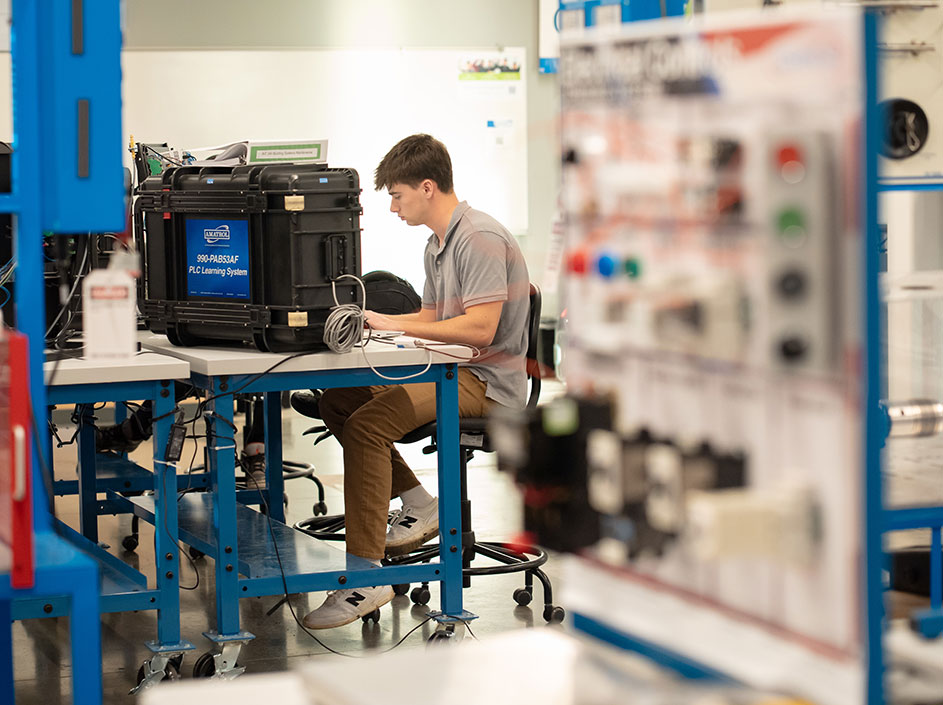
Manufacturing is not what you might expect.
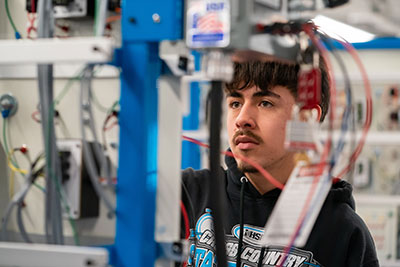 Today, smart technology is transforming the shop floor. And a career in this field is more likely to need digital skills. Robotics, automation and software are vital. They drive efficiency, improve quality and safety, and keep production lines running.
Today, smart technology is transforming the shop floor. And a career in this field is more likely to need digital skills. Robotics, automation and software are vital. They drive efficiency, improve quality and safety, and keep production lines running.
Facilities are clean, modern spaces filled with high-tech equipment. Companies pay well and offer good benefits. They want employees to keep learning. They offer a path to move up in your career.
Learn about advanced manufacturing and how to pursue a career in it.
Key points:
- Manufacturing offers good wages, strong benefits, career growth, and job stability. Work in an industry you care about. Explore why a manufacturing career makes sense.
- If you like active work, flexible shifts and solving problems, this could be the path for you. Learn what it’s really like to work in manufacturing.
- You have many options. Work in welding, industrial technology, CNC machining, software development, mechatronics or supply chain management. Explore the 7 most in-demand manufacturing jobs.
- The way to start or level up to a better career in this field is by earning a certificate or degree. Explore study programs.
- You may be able to study manufacturing without taking on debt. Get help paying for college.
- Find your purpose in a future-focused industry that uses robotics and automation. Help lead manufacturing’s transformation.
High tech to high pay: Many reasons to consider a career in manufacturing
If you want a steady career with good pay and benefits, consider manufacturing.
“The jobs in manufacturing are high-tech, high-wage jobs that will help you reach your future goals,” says manufacturing expert Dave Wooten. He chairs the industrial technology department at College of Lake County (CLC). “This career path is a great way to support yourself and your family.”
Entry level jobs start with competitive pay. Annual wages grow as you gain experience and earn credentials.
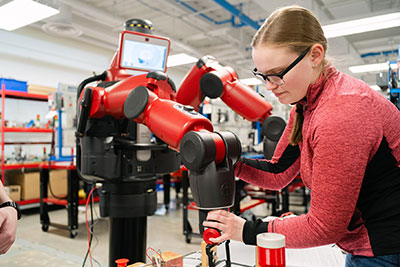 Skilled workers made more than $79,400 in 2021, reports the Illinois Manufacturers' Association. That’s 11.7% higher than what other jobs in the state pay on average.
Skilled workers made more than $79,400 in 2021, reports the Illinois Manufacturers' Association. That’s 11.7% higher than what other jobs in the state pay on average.
Benefits are good, too. According to the National Association of Manufacturers (NAM), 93% of workers had health insurance benefits in 2024.
A bonus: Manufacturing supports just about every industry. It’s possible to work in a field that interests you.
“Manufacturing is so broad. You might work for a company that makes antibiotics, guitar parts, even submarine hulls," says Wooten.
Still, it wasn’t a career path Kylie Kundert considered at first. “When I was first looking at schools, I thought manufacturing—that doesn’t sound very fun. But now I’m like, ah, manufacturing—this is great.”
She is earning an associate degree in automation, robotics and mechatronics at CLC. She knew “I would come out of it with the skills necessary to enter into the workforce.”
Kundert plans to work as a manufacturing maintenance technician after graduation. Then earn a bachelor’s degree with help from her employer. Many companies reimburse you for the cost of college tuition.
Kundert adds: “Down the road, I’d like to move into more of a research and development role, with my dream job being a Disney Imagineer.” She wants to develop humanoid figures like the animatronic Star Wars character Hondo Ohnaka at Disney World. “It’s absolutely insane,” she says of Ohnaka’s life-like demeanor.
Most employers encourage workers to develop skills through ongoing training and education. They also offer career paths for advancement.
“Manufacturers in Lake County want you to grow professionally. They support employee upskilling because this helps them grow the business,” explains Jim Connell, executive director, CLC Community and Workforce Partnerships. He works closely with the Manufacturing Alliance, which connects local manufacturers to employees, among other initiatives.
Manufacturing also can offer job stability. Companies are bringing manufacturing back to the U.S. to protect supply chains. This may increase demand for workers, says Connell.
In January 2024, U.S. manufacturers had 622,000 open jobs, according to NAM. In the next 10 years, they’ll need 4 million employees.
Find your manufacturing program
Active jobs, modern facilities and flexible shifts: What it’s like to work in manufacturing
Many different jobs exist in manufacturing operations. You might make products, like assembling medical equipment or processing food items. Or manage the equipment and supplies that make production possible. Your goal may be to reach a production quota or find ways to improve safety and efficiency. Jobs generally involve hands-on activities and high-level problem solving.
“The number of jobs in manufacturing are vast. You might program CNC machines, analyze the quality of a weld, or read complex blueprints. These skills are equal to or exceed what's needed for many traditional office-type roles,” says Jim Connell, Community and Workforce Partnerships, College of Lake County (CLC).
Manufacturing facilities today are bright, modern spaces. Companies in Lake County mostly make pharmaceutical, plastic and medical products, reports Lake County Partners, a partner with CLC. Some of this work takes place in sterile environments, or clean rooms.
Day, evening and weekend shifts may be available. You can choose a work schedule that fits the needs of you and your family.
Anyone can work in manufacturing. But those who are most satisfied in these careers share some common traits:
- You enjoy hands-on work and using technology.
- You are curious about how things work.
- You like fixing, building or programming.
- You enjoy learning new skills.
- You like being part of a team.
- You prefer moving around at work and not sitting behind a desk all day.
Find your manufacturing program
7 high-demand careers that use advanced tools, smart tech and brain power
Thomas, the online manufacturing marketplace, identified six manufacturing jobs most in-demand. With feedback from Lake County manufacturers, we added one more. They are as follows:
1. Industrial machinery mechanic / millwright
 Install, maintain and repair equipment. Your know-how of pneumatics, hydraulics, electronics, and wiring makes this possible. You understand motors, pump and piping systems, mechanical drives, lasers and process control. Learn more about industrial technology.
Install, maintain and repair equipment. Your know-how of pneumatics, hydraulics, electronics, and wiring makes this possible. You understand motors, pump and piping systems, mechanical drives, lasers and process control. Learn more about industrial technology.
“Industrial technology jobs are in demand because they cover a broad area. Every company needs people who can work on the array of high-tech machines and systems used in a facility. Our program prepares students for this work,” says manufacturing expert Dave Wooten. He chairs the industrial technology department at College of Lake County (CLC).
Demand for this job will grow 15 percent through 2033, much faster than other occupations, states the U.S. Bureau of Labor Statistics. About 53,000 jobs will need filling each year on average.
Train to work in industrial technology
2. Manufacturing maintenance technician / repair worker
 Make sure machinery and equipment operate at peak performance. Do this by inspecting, testing and calibrating machinery. Technicians troubleshoot issues, maintain parts inventories and keep maintenance logs.
Make sure machinery and equipment operate at peak performance. Do this by inspecting, testing and calibrating machinery. Technicians troubleshoot issues, maintain parts inventories and keep maintenance logs.
Companies continue to add advanced technology to their facilities. This means you may work with 3D printers, robotic machinery and automation equipment. Your work may involve internet-connected devices and programmable logic controllers (PLCs). Learn more about industrial technology.
“You could be troubleshooting machines or programming computers. One day you could be working with robots, and the next day you may be fixing a machine the size of a house,” says Wooten.
Maintenance technicians typically earned $60,500 a year in 2024, reports the U.S. Bureau of Labor Statistics. New hires make less, while experienced technicians earn more.
Train to work in industrial technology
3. Welder
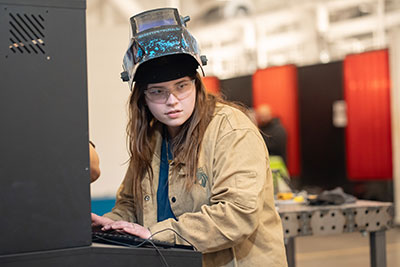 Cut or join metal using heat, gas and hand-held or remote-controlled equipment. Use skills to build ships, tractors, airplanes and equipment for different industries. A welder may work in manufacturing maintenance, repairing machinery used in a plant.
Cut or join metal using heat, gas and hand-held or remote-controlled equipment. Use skills to build ships, tractors, airplanes and equipment for different industries. A welder may work in manufacturing maintenance, repairing machinery used in a plant.
Outside manufacturing, welders work in construction. They erect buildings, bridges, oil rigs, pipelines and other infrastructure projects. Welders develop skills specific to the industries in which they work.
Welders read blueprints, polish and smooth metals, join seams and fix holes. They determine the right materials and methods for the job at hand. They follow strict safety protocols. Welders are in demand because they provide critical services across many industries.
Kyle Thorne studied welding and fabrication technology at CLC, then started his own mobile welding business. “While I love the space and equipment, it was the instructors that kept me at CLC. They helped make sure I learned the right way, and I had fun doing it.”
Experienced welders in Lake and Cook County, Illinois, may make more than $71,000 a year. Entry level roles pay less. Annual wages grow as you gain experience and earn credentials.
4. Production, planning and expediting clerk / material mover

Manage the supply chain to make sure your team has the right materials to make high-quality products on time and within budget.
Sasha Polich does this at Aircraft Propeller Service in Lake Zurich, Ill. She is warehouse manager at the propeller repair company. Polich manages the parts inventory and oversees outbound shipments of finished products. “The timing on your deliveries is everything,” she says. Polich analyzes data and collaborates with team members in other departments. This helps her forecast production needs, resolve bottlenecks and manage material shortages.
The typical salary for a planning and expediting clerk in 2023 was about $57,600, reports the U.S. Bureau of Labor Statistics. Entry level jobs pay less; experienced professionals earn more.
Polich found a passion for the supply chain at College of Lake County. An associate degree in business with a concentration in supply chain management prepares you for this role. You also can transfer, like Polich, to a four-year college to complete your bachelor’s degree.
Study business for supply chain
5. Computer numerical control (CNC) programmer
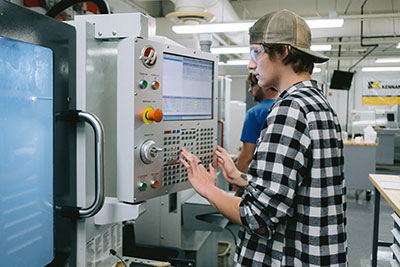 Program machinery to cut and shape raw materials into final products. Apply software and CAD drafting skills. Use know-how of metallurgy, geometric dimensioning, tolerancing, jig and fixture design.
Program machinery to cut and shape raw materials into final products. Apply software and CAD drafting skills. Use know-how of metallurgy, geometric dimensioning, tolerancing, jig and fixture design.
“A programmer looks at a solid block of metal and finds the most efficient way to turn it into a finished product," explains Eric Andersen. He teaches precision machining and welding fabrication technology at College of Lake County.
“CNC machining plays a vital role in making the products we use every day. Industries from healthcare to aerospace rely on it,” says Andersen. “We see demand for programming CNC equipment all over the country.”
In 2023, the median annual wage for CNC programmers was $67,650, reports the U.S. Bureau of Labor Statistics. Entry level salaries start lower. Wages increase as you gain experience and earn credentials.
6. Software developer
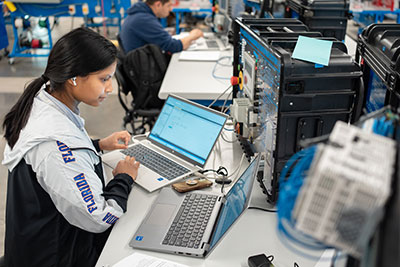 Software runs the production process, automation and robotic equipment. Manufacturing facilities need developers to design, test and maintain these programs.
Software runs the production process, automation and robotic equipment. Manufacturing facilities need developers to design, test and maintain these programs.
Demand for software developers in general is projected to grow 17 percent by 2033, reports the U.S. Bureau of Labor Statistics. About 140,100 jobs need filling each year. In Lake and Cook counties, the median salary for a software developer is about $132,000. View computer science career outlook data.
To become a software developer, you need a bachelor’s degree in computer science. You can save up to $33,000 on tuition and fees on this degree by attending College of Lake County for two years. Then, transfer as a junior to the four-year school of your choice to get your bachelor’s degree. Explore transfer options.
Likewise, manufacturers need information technology or IT experts. They maintain networks, cybersecurity and online processes. Their role is vital to keep a facility operating day to day. Explore why IT is a good career with a strong future.
Career certificates let you start working fast in IT. They take 4 months to 1.5 years to complete. Combine certificates to earn an associate degree in IT.
7. Automation, robotics and mechatronics (ARM) technician
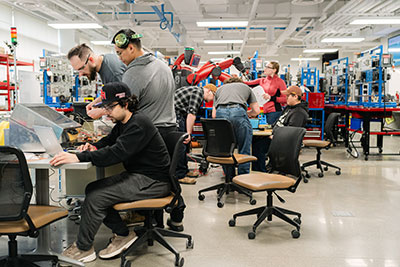 Design, program and troubleshoot automated systems. Install and maintain “smart” machines. Use knowledge of mechanical, electrical and control technology to manage connected devices.
Design, program and troubleshoot automated systems. Install and maintain “smart” machines. Use knowledge of mechanical, electrical and control technology to manage connected devices.
ARM is a game-changer in manufacturing. “It allows machines in the facility to talk to each other, share data and make decisions – all in real time. Sensors and equipment connect to the internet to monitor production. This helps a facility reduce waste and increase efficiency. And predict failures before they happen,” explains Margie Porter. She is chair of the ARM department at CLC.
Some equipment may use artificial intelligence to learn, adapt and make decisions. An example is a robotic arm that improves performance over time. Or a self-driving car that navigates safely in traffic. Other devices include drones, humanoid robots and artificial limbs.
Students at CLC study automation basics. They learn how to use programmable logic controllers (PLCs). And become proficient in several PLC and robotics languages. This helps students step into the workforce and land good jobs.
"Students are sharing they're making really good money, higher than the normal pay rate,” says CLC robotics instructor Vasil Ahchiyski. The typical wage for a mechatronics technician was $70,760 in May 2024, reports the U.S. Bureau of Labor Statistics.
Study automation, robotics and mechatronics
Tired of just working? Start earning, learning and building your future
Training and education help you get a high-paying job in manufacturing. College of Lake County (CLC) teaches you the skills that local manufacturers want. You train on the same technology that you'd find in a modern manufacturing facility.
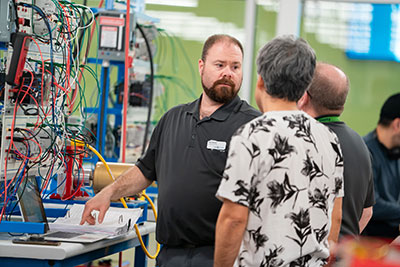 “CLC has invested heavily in new technology and training. Students are learning on 21st-century equipment and tools. When we bring manufacturers through our Advanced Technology Center, they are amazed at the equipment we use to train. It's often exactly what they have in their own facilities,” says Jim Connell, CLC Community and Workforce Partnerships.
“CLC has invested heavily in new technology and training. Students are learning on 21st-century equipment and tools. When we bring manufacturers through our Advanced Technology Center, they are amazed at the equipment we use to train. It's often exactly what they have in their own facilities,” says Jim Connell, CLC Community and Workforce Partnerships.
Students learn how to use programmable logic controllers (PLCs), robotic welders and high-tech automation systems.
You can take these skills anywhere in the world. They help you switch careers or move up in your current job to a next-level or supervisory role. Manufacturing technology is always evolving so it’s important to keep learning.
It's easy to upskill. "Maybe you want to earn a degree or certificate to take the next step in your career. CLC offers many opportunities for both,” adds Connell.
Chad Holt did this. He knew he needed more education to advance in his career. So, he enrolled at CLC. He earned one degree in mechanical engineering technology and a second degree in automation, robotics and mechatronics. "It's really helped me to polish and hone my skills,” says Holt. He now leads operations at an industrial saw blade maker.
CLC students take field trips to see advanced manufacturing at work. They tour high-tech manufacturing facilities several times each semester. They attend trade shows like the Automate Show and IMTS, the International Manufacturing Technology Show. Students also compete at SkillsUSA Illinois. In 2024, two CLC students won gold medals in the mechatronics competition. Read about CLC at SkillsUSA.
Here is how to build your knowledge and skills:
Get a career certificate
Career certificates help you gain skills fast to start or advance in your career. They take 4 months to 2 years to complete. They range in cost from about $2,000 to $11,000. It may be possible to combine certificates to earn an associate degree. You can get a certificate from CLC in industrial technology, IT, welding, mechatronics or CNC machining.
Earn an associate degree
Associate degrees prepare you to begin work right away. They take about 2 years to complete if you’re going to school full time. The cost is $12,000 to $13,000. Earn an associate degree from CLC in welding, IT, business, CNC machining, industrial technology or automation, robotics and mechatronics.
Transfer to get a bachelor’s degree
If you want to get a bachelor’s degree, start by earning a 2-year transfer degree at CLC. Then transfer as a junior to the 4-year school of your choice to finish your studies.
This will save you up to $33,000 in tuition in fees, according to the CLC Community Impact Report 2025. If you live at home while attending CLC, you save even more money on room and board.
You can earn a transfer degree in computer science, IT, business administration, and automation, robotics and mechatronics. Transfer degrees costs about $12,000. You can transfer to an away school. Or stay local and complete a bachelor's degree through University Center of Lake County. Learn how to transfer to a 4-year school.
Get help paying for college
Become an apprentice: Make money while you learn debt free
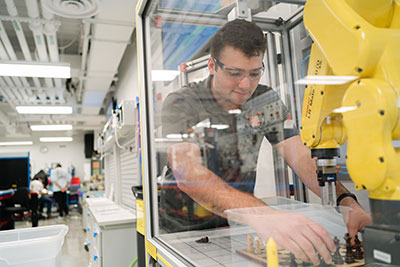 Local manufacturers offer apprenticeships to CLC students. The company pays your tuition and fees to attend college. You also get paid to work at the company. There, you practice the skills you learn in class. You gain hands-on training from a workplace mentor. Many apprenticeships turn into full-time positions. They help you complete college debt-free.
Local manufacturers offer apprenticeships to CLC students. The company pays your tuition and fees to attend college. You also get paid to work at the company. There, you practice the skills you learn in class. You gain hands-on training from a workplace mentor. Many apprenticeships turn into full-time positions. They help you complete college debt-free.
Apply for financial aid and scholarships, like from rock band Metallica
Financial aid can help reduce the cost of attending college. This includes scholarships, grants and work study programs.
The Metallica Scholars initiative helped Andrew Carrasco start a new career in automation. The rock band Metallica funds the scholarship. "I was overjoyed when I won because it was a good amount," Carrasco told the Association for Manufacturing Technology.
Another source of money is the Community Project Advanced Technologies Scholarship. The U.S. Department of Labor Employment and Training Administration supports this scholarship.
Find your purpose in modern manufacturing
Gabewil Mattheau Chan Sanoria planned to study massage therapy. Then he saw the automation, robotics and mechatronics (ARM) lab at College of Lake County (CLC). “I was like, wow, this is something I’ve always wanted to do.”
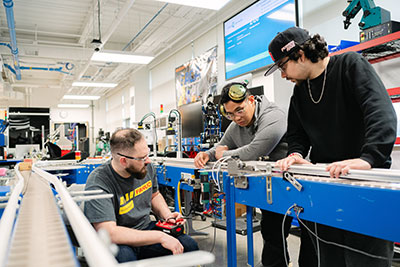 The lab brought back childhood memories of taking things apart to see how they worked. And he realized robotics could play a role in advancing the caregiving profession.
The lab brought back childhood memories of taking things apart to see how they worked. And he realized robotics could play a role in advancing the caregiving profession.
"We want to live in a society where everyone's taken care of and I think robotics could push that forward,” says Sanoria, who is earning an associate degree in ARM.
“My mom’s a caregiver,” he adds. “In time, maybe we will have sensors or robotic systems that will aid in ensuring the longevity of life and enable her to do her job better.”
Sanoria hopes to find out. He plans to work in manufacturing when he graduates and eventually start his own business. "I want to be an innovator.”
Help lead manufacturing into the future
Manufacturing holds purpose for many people. The industry is evolving. It needs tech-minded individuals to lead its transformation.
Today, even warehouses use mobile industrial robots to pick and pack orders. This makes the process faster and improves worker safety.
“There’s always improvement in automation,” says CLC mechatronics instructor Ken Albrecht.
Today manufacturing uses industrial robots to perform tasks and improve workplace safety. Coming on the scene: new technologies like collaborative robots, which work alongside humans. Having a robotic helper that you direct boosts productivity. Soon, humanoid robots that run on artificial intelligence may work in manufacturing facilities.
These advancements create more opportunities for students who pursue careers in advanced manufacturing.
"Right now, we're switching between industry 4.0 and industry 5.0. This is the new generation of industry,” says robotics expert Vasil Ahchiyski. He teaches mechatronics at CLC.
